McLaren has delivered its new car for the 2019 F1 season while its technical department is in a state of flux, awaiting the arrival of new technical director James Key from Toro Rosso. Craig Scarborough appraises the team’s new MCL34 chassis.
McLaren’s championship result last season belied the underlying problems with the car’s aerodynamic performance. Problems with the MCL33 further eroded the team’s prestige and the 2019 season marks another drive to bring the team back to competitiveness.
The first impression of the all-new MCL34 is that there has been a concerted effort to resolve both the shortcomings of the old car and making a step change in its performance.
Repackaging
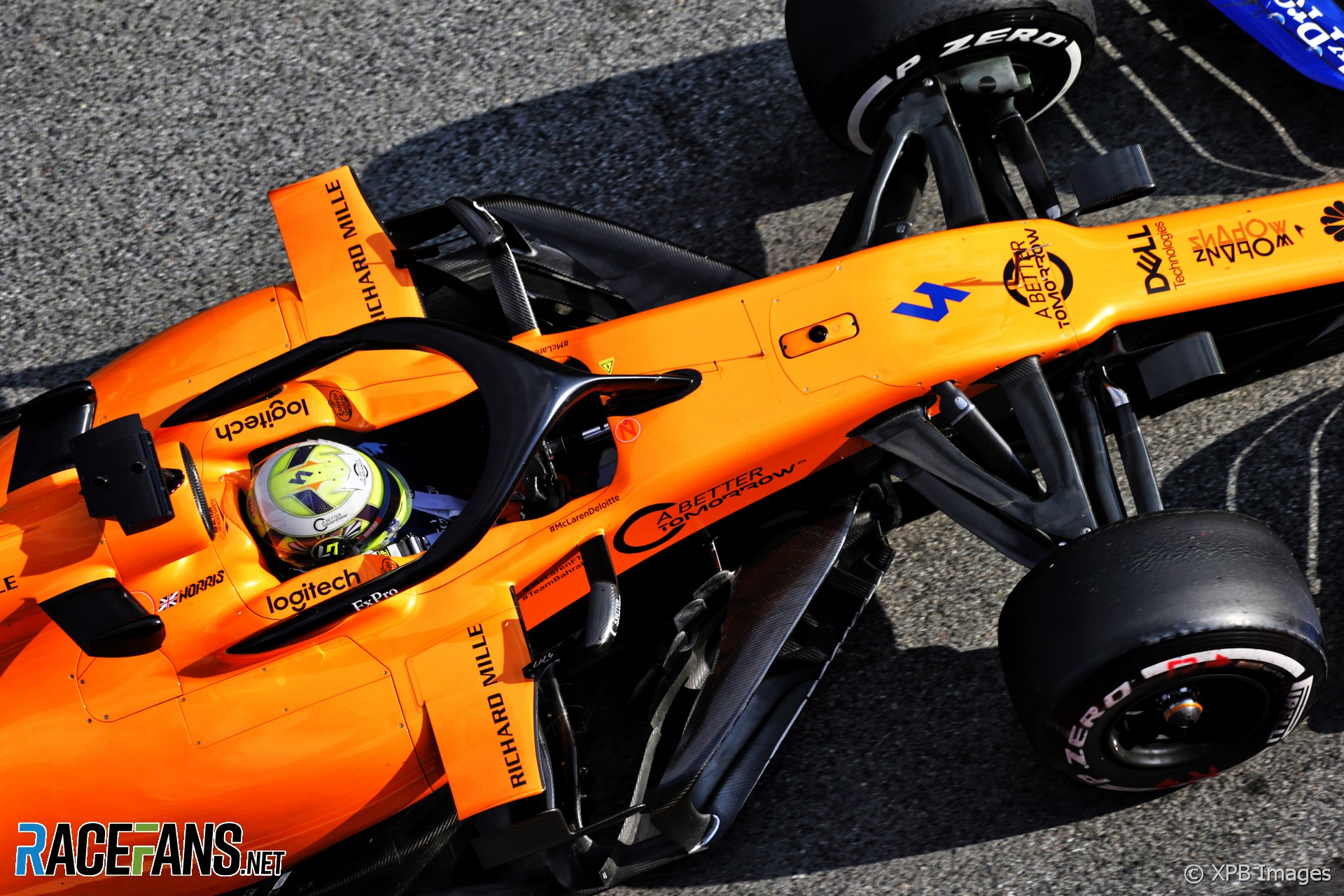
The position of the front axle must be ahead of the driver’s feet, but teams are free to position it further forward than that, and most do. While the sidepods and the floor’s lower leading edge are fixed relative to the cockpit opening, thus the drivers foot position ahead of them, teams will alter the front axle position to give themselves space to fit bargeboards and direct airflow around the car.
It seems McLaren’s error was to place the front axle too close to the sidepods, limiting possibilities with the aerodynamics in this area. Correcting the error for this season has seen McLaren push the front axle further forwards, extending the car’s overall wheelbase in the process.
Go ad-free for just £1 per month
>> Find out more and sign up
Front suspension
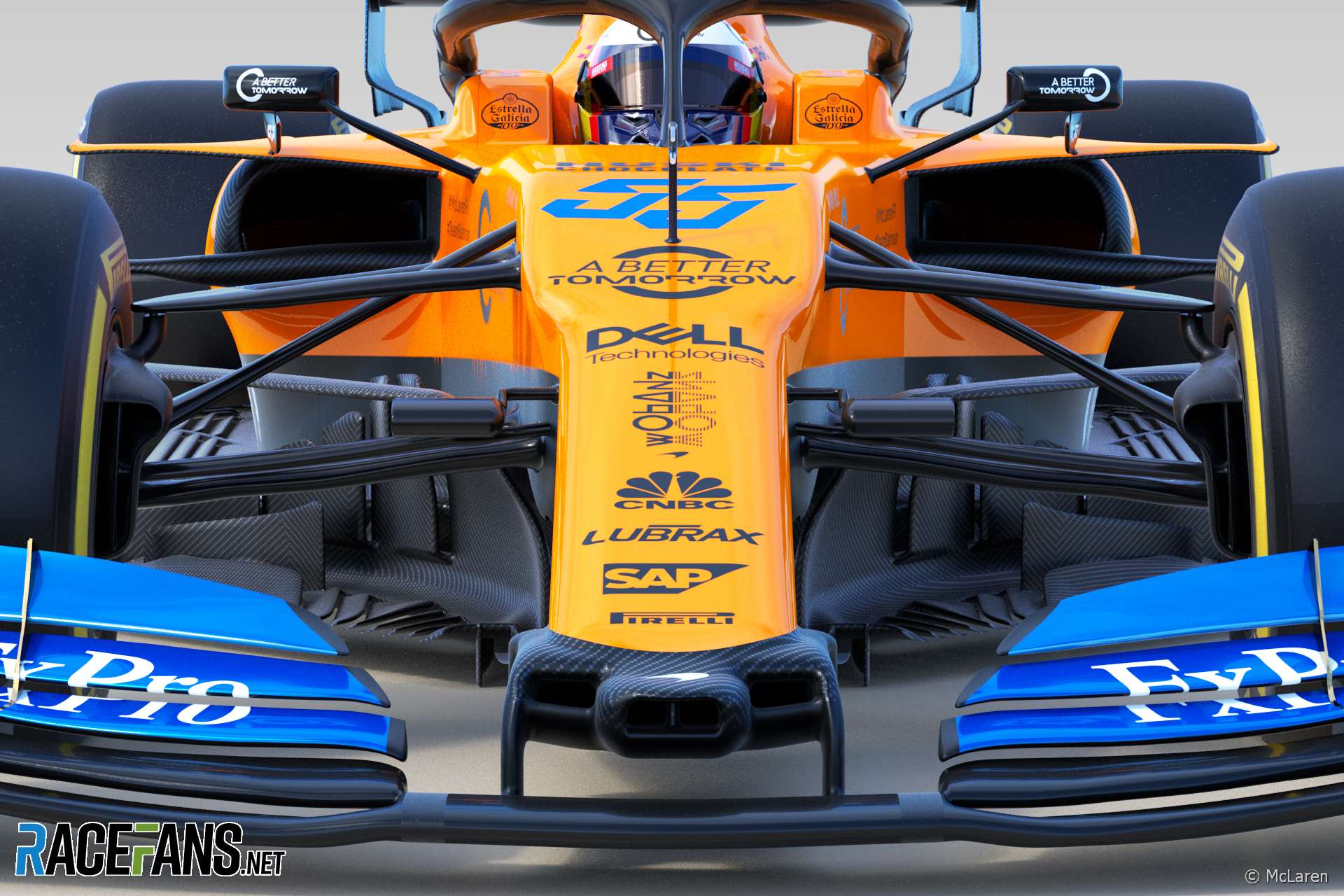
A major change in design concept for the MCL34 is the front suspension, albeit not directly related to the front axle position change. Following the Mercedes concept of very high mounted wishbones has required a completely new suspension set up.
McLaren’s implementation of the high mounting is like other teams’ interpretations, with the top wishbone meeting the front upright at an extension protruding upwards through the brake duct. This allows the lower wishbone to be raised by a similar amount.
In 2019 the grid is split on the front suspension layout. Unlike last season the higher or lower wishbone mounting appears to be unrelated to the sidepod philosophy. By mounting the wishbones higher, the space beneath them is opened up for airflow below, specifically the front wings upwash and Y250 vortex. By not obstructing the front wing’s wake the wing becomes more effective and there is greater airflow towards the bargeboards.
Advert | Become a RaceFans supporter and
Bargeboards
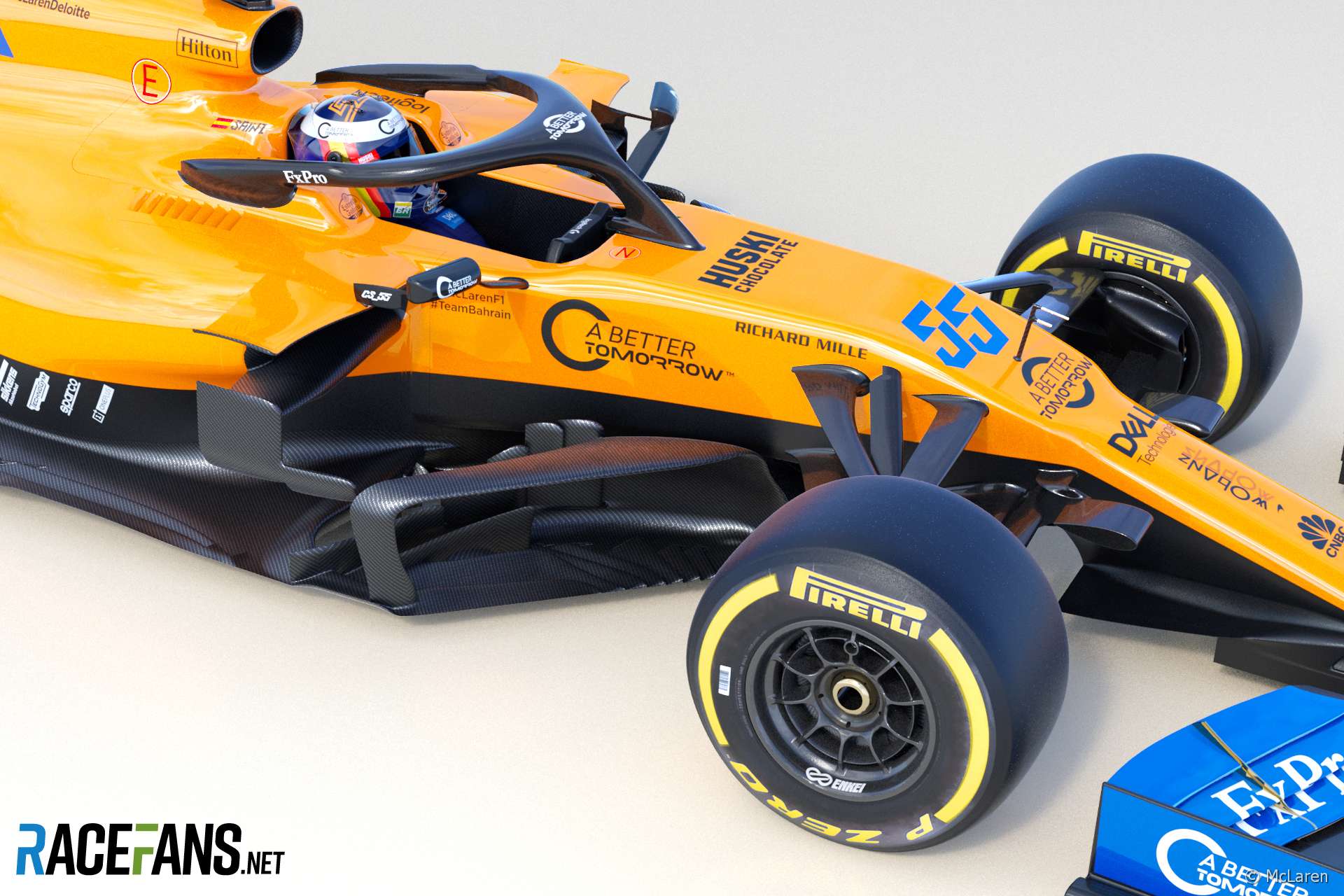
For 2019 the bargeboard regulations do little to reduce complexity, but do impose a lower overall height restriction for the main bargeboard legality box. This wedge-shaped legality box is exploited to its geometrical maximum by McLaren.
The leading face of the wedge is filled with a wrap-around vane which looks more like it’s from a future F1 concept. Despite looking like a stylised element, this device actually works. It’s more like two aerodynamic devices in one, the lower element is part of the usual bargeboard footplate set up, which sends air around and under the sidepods.
The upper element is a derivative of the ‘boomerang’ wing, used commonly in a high position last season. A boomerang is used to create downwash, to direct the front wing’s upwash downwards to the rear of the car. With the height restrictions, the boomerang needed to be lowered and this McLaren solution retains some of the downwash effect, packaged neatly into the rest of the bargeboard arrangement.
Advert | Become a RaceFans supporter and
F1 technology
- Pictures: Alpine’s new front wing and more Suzuka updates
- Pictures: Red Bull bring first performance upgrade for RB20
- How teams have tweaked their cars to hit higher speeds in Jeddah
- ‘A horrible project’: Why duplicating Red Bull’s trend-setting suspension is so difficult
- Aston Martin, Mercedes, Haas and others describe extensive US GP updates
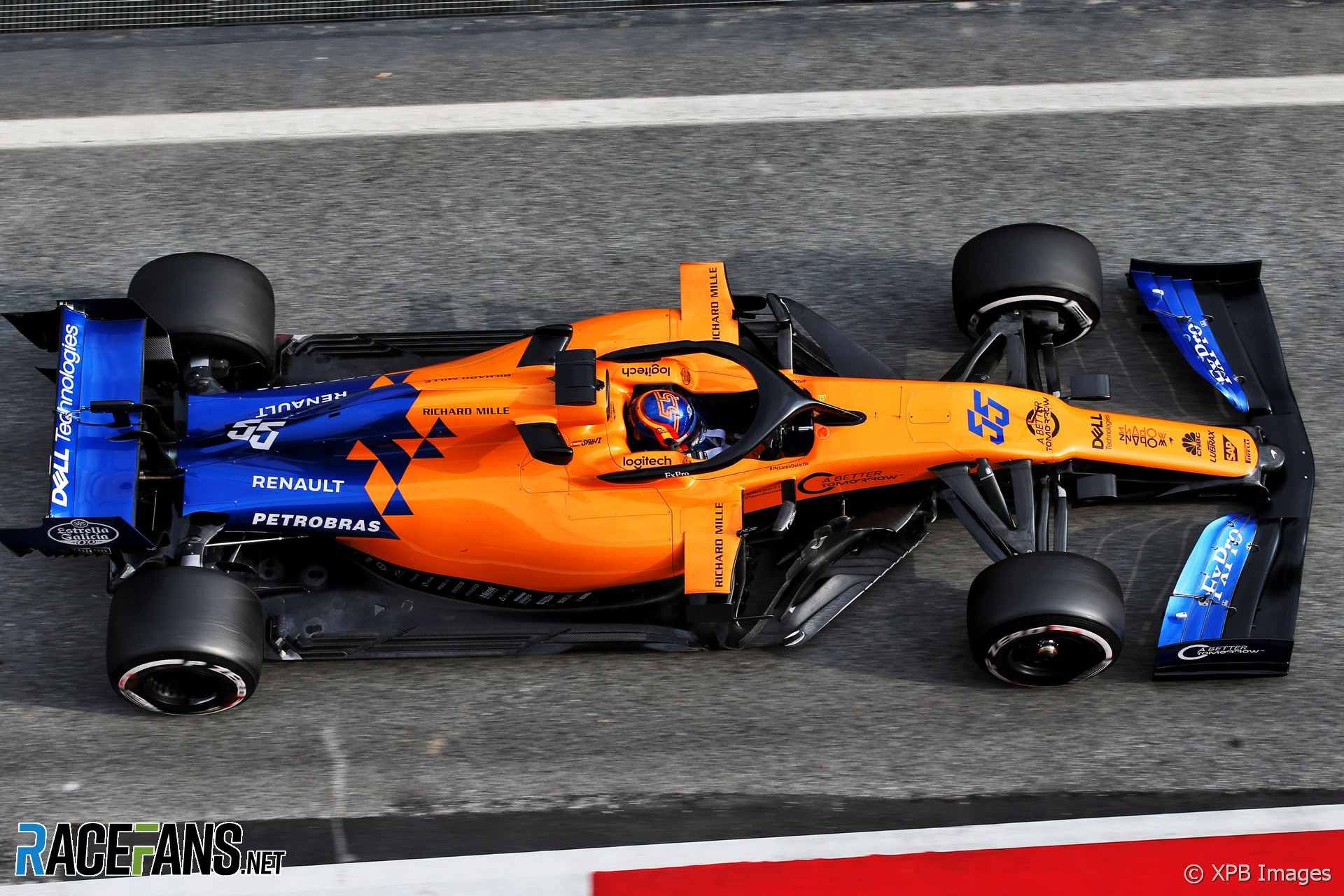




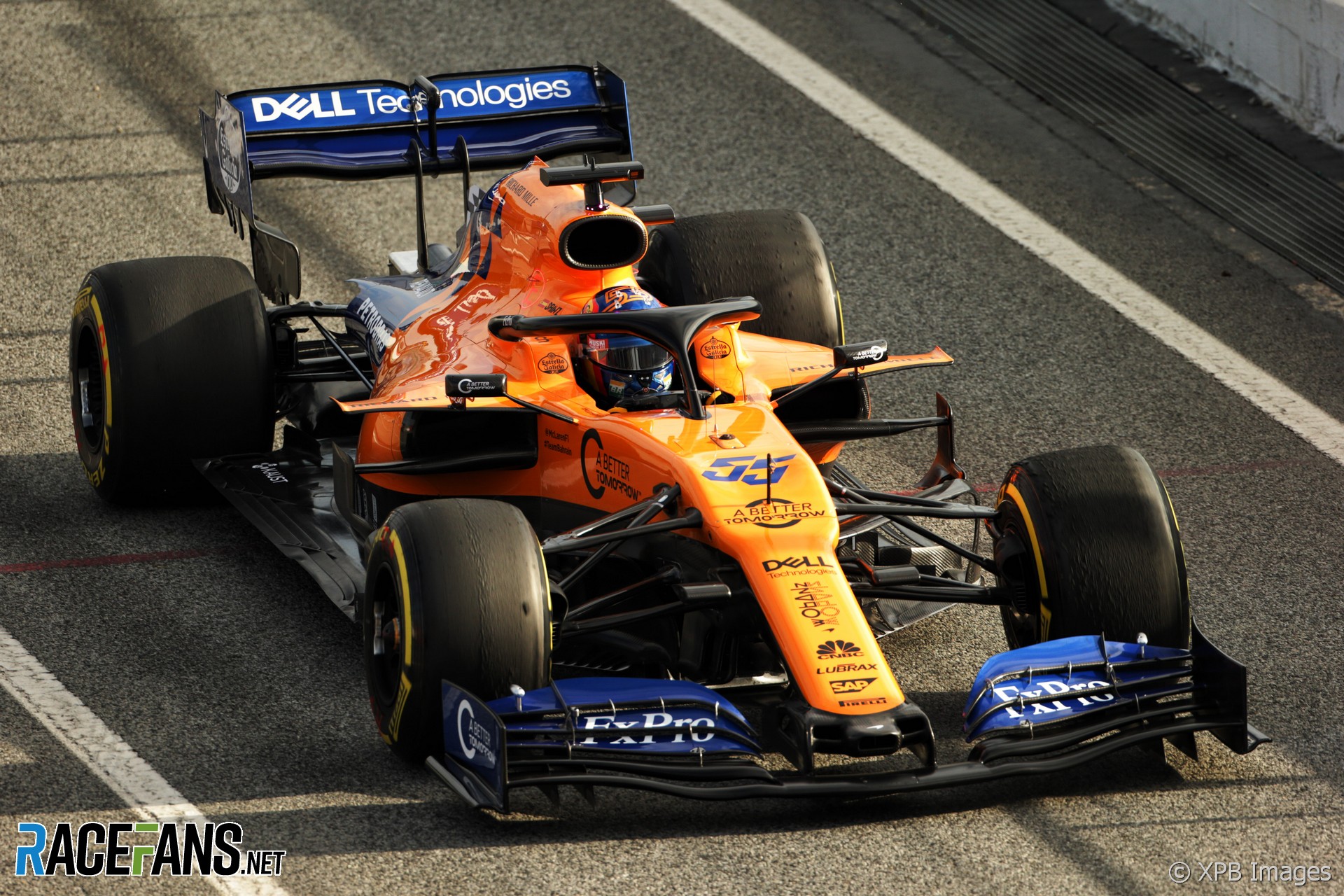
JayMcG (@jaymcg)
25th February 2019, 12:48
You’ve missed quite a few things here.
Rear wing end plates
Nose
Engine repackaging
Diffuser
Wings above sidepods
Phylyp (@phylyp)
25th February 2019, 13:11
That’s promising. I look forward to the Williams analysis as well, these are two teams that need to get into the thick of the midfield.
I don’t mind a two-tier F1 championship, but would dread a three-tier one.
DB-C90 (@dbradock)
25th February 2019, 21:23
I agree. It’s great that we now get these articles and can get an insight into just how much effort has gone into turning around the fortunes of a team.
It also highlights to me some of the reasons why it’s so difficult to recover if a fundamental error (like positioning of the front wheels) is made at the start of a season. Changing that I’m guessing would require pretty much a complete chassis redesign, something that most teams would not be able to achieve within a season.
tonyyeb (@tonyyeb)
26th February 2019, 11:43
@phylyp The days when Ben Edwards would announce 10 laps from the end “And lets see who is winning the ‘new teams’ battle…” was just embarrassing for those and added very little value to the viewers having never seen those cars in the coverage up until that point.
Phylyp (@phylyp)
26th February 2019, 11:56
@tonyyeb – are you referring to the turn of the decade, when we had the three teams at the tail-end? Yeah, that was a sad time. Good that they were participating, but a shame they couldn’t really rise above the tail-end.
tonyyeb (@tonyyeb)
26th February 2019, 12:00
@phylyp Exactly. It sadly showed how difficult the challenge for a new team is (without buying a certain percentage of a Ferrari) but also it was like “and lets see how the slow cars are doing…”
ColdFly (@)
25th February 2019, 13:16
Thanks @scarbs, great insights/article.
What happened with the upper ‘boomerang’ element in the lower picture (Sainz)?
On the right-hand side it looks like a shark took a bite out of it.
Phylyp (@phylyp)
25th February 2019, 13:23
Nicely spotted!
Mach1 (@mach1)
25th February 2019, 14:14
Did that not happen on one of the test days? The element broke off on one of their cars during, it was captured on video. Not sure if the element failed or it was due to an off elsewhere though.
Ryan
25th February 2019, 14:18
Depends on when the picture was taken, but I remember a piece of bodywork flying off the McLaren on Day 3 when Sainz was driving. Maybe this was the piece that broke off?
coefficient
25th February 2019, 14:39
They kept snapping under load during testing last week. It’s not a big deal, they’ll just reinforce it probs with a titanium spine.
BlackJackFan
25th February 2019, 14:55
A bit off topic… but can anyone simply explain what the aero-boys do that allows a total lack of any kind of windscreen…? Please.
Lee1
25th February 2019, 15:32
The airflow off the front wing and nose deflect upwards into the air box and form a sort of air screen. Also the drivers have their very own windscreen right in front of their faces…
Fudge Kobayashi (@)
25th February 2019, 16:25
As above – engineers work hard to create relief for the driver from excessive buffeting despite their helmet. I remember when they first trialled the Halo it messed up some of the aero flows they use to control that and drivers suffered excessive buffeting and lift with the early prototypes.
MtlRacer (@mtlracer)
25th February 2019, 16:41
There’s no need for a windscreen. For a complete explanation, lookup the Ferrari Monza SP “Virtual Windshield”.
Benny
25th February 2019, 15:51
I notice that at launch the MCL had a small fin where the number went, yet on the bottom photo it must have evolved into a full blown shark fin… Not sure what it all means but just noticed it.
I have a sneaky suspicion that, despite some analysis fretting about McLaren’s progress, they’re running very conservatively and experimenting. Just to build a proper platform to progress with, finally. Here’s hoping that’s the case and they start to turn up the wick soon!
Stevo
25th February 2019, 19:34
No, perhaps it is the angle but it’s still the same as the launch.
MtlRacer (@mtlracer)
25th February 2019, 16:44
All those tiny carbon fibre winglets (best seen in 3rd pic) look like they’ll break-off and go slice someone’s tyres.
Lancer033 (@lancer033)
25th February 2019, 17:13
…maybe that’s their plan to avoid getting lapped
juan fanger (@juan-fanger)
25th February 2019, 20:00
It’s all about the front half of the cars these days.
Sattalyte (@sattalyte)
25th February 2019, 20:43
I feel like this is important and would be interesting, but I don’t understand it. An explanation of what the terms mean is needed here – which part is the front upright, lower wishbone etc? Also, a picture of the new and old set up would be really helpful. I love these technical articles, but they assume too much prior knowledge.
Phylyp (@phylyp)
25th February 2019, 21:25
@sattalyte – my technical knowledge of an F1 car might not be great, but let me give it a shot.
Firstly, look at the second picture (top view of the front of the car). Can you see a thick black V-shaped part connecting the wheel to the front of the car? The broad part of the V is on the car, the tip of the V is on the wheel. That is the wishbone, since it literally resembles the wishbone of a bird.
There are two wishbones, the upper and lower one. If you look at the third picture, you can see both wishbones from the front, they are the ones that are almost horizontal, but only slightly tilted. The wishbones allow a wheel to move up and down (i.e. the range of suspension travel). There is another arm that is at a greater angle, that is – I believe – the steering arm.
Now, in that same third picture, look at the left of the picture (front-right wheel of the car), where the wishbone meets the tyre. Can you see a small J-shaped part at the very tip of the wishbone? That is the “extension protruding upwards through the brake duct”.
The front upright is a roughly vertical part that connects the tips of the upper and lower wishbone. The wheel hub is fitted to this upright, and the upright can swivel to allow a wheel to steer. To give you a better view of what an upright looks like, take a look at this Wikipedia image – by now you will be able to identify the two horizontally-aligned wishbones (painted yellow), and the upright (also yellow). If you look at the 3 corners of the upper wishbone, you can see the two bushes in the background that allow the wishbone to swivel up and down, and the third bush in the foreground that allows the upright to pivot based on steering input.
Hope this helps, and I’d look to others to chip in with any additions/corrections, or with the pictures you seek.
Rhys Lloyd (@justrhysism)
26th February 2019, 2:13
@sattalyte I agree – I love reading these articles, but feel like a buffoon for not always knowing what the author is talking about.
@keithcollantine would it be possible to have the images annotated (with a number or something which the article references) and maybe a technical glossary available elsewhere on RaceFans.net which keywords can be linked to (for further explanation of purpose and some examples)? The glossary could be built up over time, but I feel like that would be a really valuable asset to further engage fans (both of F1 and RaceFans, new and rusted-on).
Food for thought :)